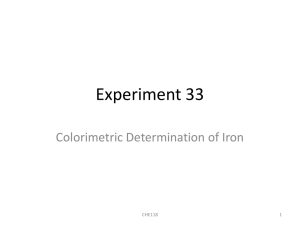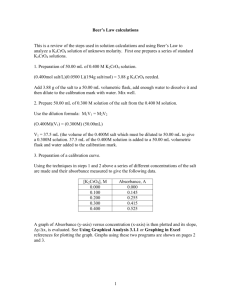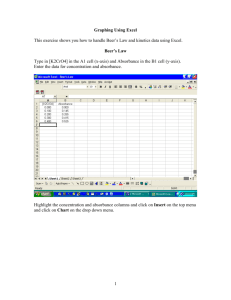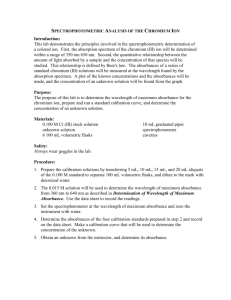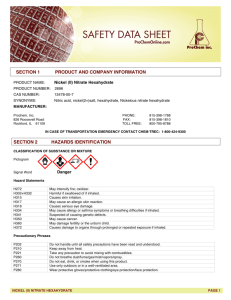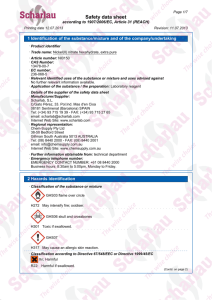Nickel Solution Concentration: Beer's Law Lab
advertisement
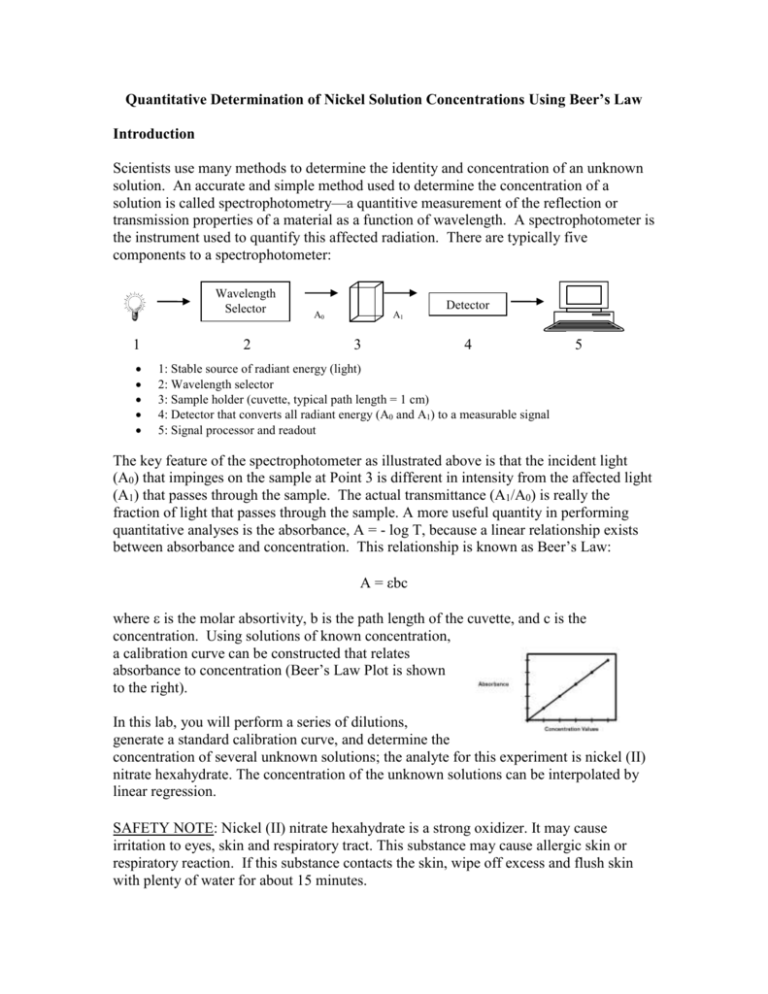
Quantitative Determination of Nickel Solution Concentrations Using Beer’s Law Introduction Scientists use many methods to determine the identity and concentration of an unknown solution. An accurate and simple method used to determine the concentration of a solution is called spectrophotometry—a quantitive measurement of the reflection or transmission properties of a material as a function of wavelength. A spectrophotometer is the instrument used to quantify this affected radiation. There are typically five components to a spectrophotometer: Wavelength Selector 1 2 A0 A1 3 Detector 4 5 1: Stable source of radiant energy (light) 2: Wavelength selector 3: Sample holder (cuvette, typical path length = 1 cm) 4: Detector that converts all radiant energy (A0 and A1) to a measurable signal 5: Signal processor and readout The key feature of the spectrophotometer as illustrated above is that the incident light (A0) that impinges on the sample at Point 3 is different in intensity from the affected light (A1) that passes through the sample. The actual transmittance (A1/A0) is really the fraction of light that passes through the sample. A more useful quantity in performing quantitative analyses is the absorbance, A = - log T, because a linear relationship exists between absorbance and concentration. This relationship is known as Beer’s Law: A = bc where is the molar absortivity, b is the path length of the cuvette, and c is the concentration. Using solutions of known concentration, a calibration curve can be constructed that relates absorbance to concentration (Beer’s Law Plot is shown to the right). In this lab, you will perform a series of dilutions, generate a standard calibration curve, and determine the concentration of several unknown solutions; the analyte for this experiment is nickel (II) nitrate hexahydrate. The concentration of the unknown solutions can be interpolated by linear regression. SAFETY NOTE: Nickel (II) nitrate hexahydrate is a strong oxidizer. It may cause irritation to eyes, skin and respiratory tract. This substance may cause allergic skin or respiratory reaction. If this substance contacts the skin, wipe off excess and flush skin with plenty of water for about 15 minutes. Procedure A. Preparation and Absorption Readings of Standard Solutions You will make a stock solution of nickel (II) nitrate hexahydrate (also called nickelous nitrate) at a concentration of approximately 0.34 M. 1. Weigh ~ 5g of nickel (II) nitrate hexahydrate in a medium-sized weigh boat. 2. Using a small plastic funnel and distilled water bottle, dissolve the solid in a 50.00-mL volumetric flask with a minimal amount of water. 3. Swirl the flask to ensure that the solid has dissolved in the water. 4. Continue to add distilled water up to the volumetric mark on the flask. 5. Stopper the flask with the glass stopper and shake the flask to make the solution. 6. Take this solution, the distilled water bottle, and a disposable pipet to the spectrophotometer for your first measurement. 7. Follow the directions on the Instrument Guide to obtain an absorption spectrum of your solution. PLEASE SAVE YOUR STOCK SOLUTION!!! From this spectrum, you should determine the wavelength closest to 400nm that has the highest absorbence. This value will be used in Part 8. What next? You decide… Now, you need to make four other solutions that have lower concentrations than the stock solution. Make dilutions (recall M1V1=M2V2) of your stock. Available equipment include: three volumetric flasks per group, a variety of volumetric pipets, and a pipet bulb. Keep in mind that you are able to make two solutions at a time and once made—they can easily be transferred to beakers. HINT: Make the solutions in decreasing order of concentration. 9. Follow the directions on the Instrument Guide to obtain absorption ‘simple reads’ of your standard solutions. Record these absorption readings in a data table. B. Analysis of Unknowns Again, use the UV-Vis instrument to obtain absorption ‘simple reads’ of two unknown solutions at max. Be sure to note which unknown solutions your group decided to use. Data & Analysis A. Preparation of Absorption Readings of Standard Solutions * Please show a sample dilution calculation for one of your standard solutions. * max for ~ 0.34 M Nickelous nitrate solution = ______________nm Solution 1 2 3 4 5 Concentration (mol/L) 0.34 Absorbance Standard Calibration Curve Generate an Excel graph of Absorbance on the y-axis versus concentration on the x-axis (see example chart below). Obtain a linear trendline in the specified concentration range. Include the equation of the line and the R-value on your standard curve. Solution 1 2 3 4 5 [x-axis values] Concentration (mol/L) An example Beer’s Law plot is shown below: [y-axis values] Absorbance (unitless) If you are feeling quite adventurous, add a column to your chart (above) entitled standard deviation (calculate this value) and modify the data points on your graph with error bars (± standard deviation). B. Analysis of Unknowns Using the absorbance of unknown solution as a guide (review the above graph), locate its concentration on the y-axis of your graph. Use a straight-edge to draw a horizontal line (do not sketch) from the y-axis to the point at which this line intersects the calibration curve. Then draw a vertical line (again, using a straight edge) from that point down to the x-axis. In order to obtain an accurate value for the concentration of the unknown solutions, use your equation of the standard calibration line by plugging in the absorbance to solve for the concentration; recall which values are x-values and y-values. Unknown # Absorbance Concentration (mol/L) Be sure to show sample calculations of how you determine the concentration of the unknown solutions in your lab notebook. ALL NICKEL SOLUTIONS SHOULD BE DISPOSED OF IN THE WASTE CONTAINER IN THE HOOD. Follow-up Questions 1. Take a look at Beer’s Law and your standard calibration line equation; what value would have? Be sure to report the appropriate units. 2. What physical process is being observed using spectrophotometric measurements? 3. A 0.5 M nickelous nitrate solution was used to prepare the remaining standard solutions for a Beer’s Law plot. If 10.0 mL of each standard solution is prepared, what volume of 0.5 M nickelous nitrate is needed to prepare a 0.15 M standard solution? Show all of your work. 4. What are the concentrations of your unknown solutions? Did you expect this value for the concentration? Why or why not?
